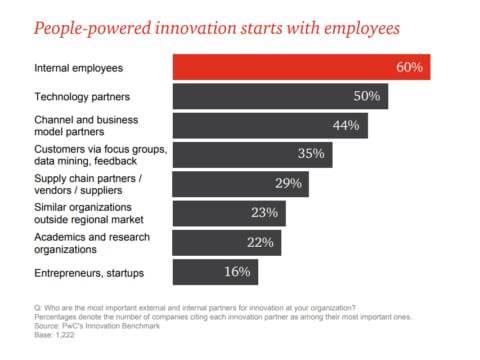What is meant by internal communication and why is it important?
Internal communication is “sharing information within an organization for business purposes’’ (Business Dictionary). It happens across organizations throughout the day.
Enabling Decision-Making at All Levels
Effective internal communication empowers employees at all levels to contribute to the decision-making process. Employees who feel their opinions and ideas are valued become more engaged and motivated. Organizations tap into their workforce’s collective knowledge and expertise by fostering a culture of open communication. This inclusivity leads to better decisions and enhances employee satisfaction and loyalty. Encouraging employees to share their insights and perspectives ensures a more holistic approach to problem-solving and innovation.
What are the types of internal communication?
Communication takes various forms and flows in different directions:
- Top-down
- Bottom-up
- Laterally
A one-way internal communication system is a surefire way of creating confusion and missed messages. You should build your internal communications strategy with communications flowing up, down, and across.
Why are top-down communications important?
Top-down communication is a one-way system where management send messages to employees.
At its most extreme, top-down communication forms part of an autocratic management style. One person at the top makes the decisions passed ‘down the chain’ to employees without input. According to HubSpot, the only situation where this is appropriate is ‘’when the organization experiences a crisis situation and needs to make important decisions — fast.’’ The Covid pandemic is a good case of this. Governments imposed lockdowns and restrictions with little notice. Management needed to send crisis communications quickly and inform employees of work-from-home regulations or new safety policies.

Promoting Efficiency and Clarity
Top-down communications ensure everyone receives the right information and can do their jobs effectively. When done well, this communication flow helps employees understand what is happening in the business. However, leadership face a challenge, three-quarters of employees feel they aren’t receiving all company updates. When people feel left out of the loop, it can lead to disengagement. This result in decreased motivation and lower productivity. Efficient top-down communication channels and practices help streamline processes, minimize delays, and ensure everyone is on the same page.
Senior management must communicate with employees daily, sharing important announcements, organizational changes, and good-news stories. However, it should be part of a more holistic communication structure.
How to Improve Top-Down Communication in Your Organization?
To enhance top-down communication within your organization, it’s important to establish clear communication channels and encourage feedback and openness. Here are a few strategies to consider:
Establish Clear Communication Channels
Create formal channels, such as company-wide emails, intranet platforms, or newsletters, for leaders to share important updates, announcements, and strategic information. This ensures that employees receive consistent and accurate messages directly from management. Clear communication channels help eliminate the chances of information getting lost or distorted as it trickles down the pyramid.
Encourage Feedback and Openness
Promote a culture of feedback and openness where employees feel comfortable providing input and sharing their perspectives. Actively seek employee feedback through surveys, town hall meetings, or suggestion boxes. Regularly communicate the importance of employee input and demonstrate that their opinions are valued. Encouraging two-way communication fosters trust and helps identify potential areas for improvement.
Internal communications tools for top-down sharing
Email is an option for sending mass messages to employees. It’s straightforward and can target a specific audience. However, over a quarter of employees consider email a ‘productivity killer.’ One study found that 40% of an employee’s workweek is filled with emails that don’t add value to the company. Unless the communication is urgent and time-sensitive, it’s likely to get lost in a crowded inbox.
Intranet
An intranet is an ideal space to communicate messages to employees as part of an internal communications program. With a corporate portal, management can share company updates or regular announcements. Messages on an intranet can be more detailed and engaging than email.
Ensuring your employees never miss a message is achieved with a few best practices:
- Define a posting schedule: For example, sharing a quarterly company update or a monthly message from the CEO.
- Keep the intranet updated: Ensure you have a dedicated team or person responsible for adding new content regularly.
- Target employees: Make sure users get information that’s relevant to them. Avoid overload with targeted content filters.
Why include bottom-up communication in your internal communications strategy?
A great internal communications strategy doesn’t rely on top-down information sharing but opens the floor to employees.
Bottom-up communication is when information and ideas come from employees. It is a democratic system that removes hierarchical barriers so employees are free to contribute regardless of their title. Open communication builds strong connections. Employees become more invested and motivated. Allowing employees to engage in conversations and share ideas leads to innovation and creativity. PWC found that 60% of innovations come from employees.
However, effective bottom-up communication relies on open and inclusive culture. Employees must feel safe to contribute and be allowed to fail. Openness to ideas but punishing failure will only cause fear and reluctance to share.
Over-reliance on bottom-up communication in a good internal communications strategy can cause issues. When too many voices are involved in a conversation, and no one is taking the lead, there’s discussion and questions but no action. It’s great to have everyone involved, but people need leadership. Top-down communication is important to align everyone in an organization. Employees should be working towards a common vision.

Internal communications tools for bottom-up sharing
Intranet
While an obvious place for top-down communications, intranet content should come from everyone. A corporate portal should reflect the culture of your organization. If a bottom-up internal communications strategy is the goal, your intranet should be populated by all. You can achieve this by encouraging departments and individuals to post announcements and updates. There are endless ideas for engaging content that can be shared across an intranet.
Teams
Microsoft Teams is a collaboration platform and the ideal space to facilitate bottom-up employee communication. Known for its information-sharing functions, Teams allows ideas to flow from employees to management. However, there’s a danger that with no guidance, employees see Teams as a place to just instant message co-workers.
Key steps to effective bottom-up communication in Teams:
- Ensure all levels of management are in the discussion: remember, ‘hierarchy’ is eliminated.
- Clearly define idea-sharing channels: create safe spaces to share ideas.
- Introduce visual tools: integrate idea-sharing apps and tabs.
- Dedicate a ‘prompter’: have someone reignite the channel weekly if conversations die out.
- Create specific conversations per topic: keep ideas together so everyone can easily find them.
- Encourage employee engagement: collaboration is about commenting, sharing, and joining the discussion.
- Define the next steps: ideas should lead to action, assign takes, and set a plan.
Can lateral communication improve internal communications?
Lateral communication is ‘’Messages and systems of interaction and feedback between individuals or departments on the same level in an organization’’ (Oxford Reference).
For the majority of organizations, collaboration between employees is critical. Staff talking between themselves, brainstorming, or running projects makes a business run. But teamwork is a skill that needs to be nurtured.
Departments must also communicate among themselves. For example, marketing can’t push a new product that the R&D team has developed if they don’t know about it. R&D won’t identify updates if sales and customer success aren’t feeding back customer thoughts.
Lateral communication is fundamental in any internal communications plan but can easily break down. Individualistic thinking or silos can result in misalignment, miscommunication, and chaos.
Having the right tools will improve your internal communications.

Internal communications tools for lateral sharing
Email has been the go-to tool for communicating with colleagues, but it’s being replaced. In a world where people expect instant feedback, email is slow. It’s also not conducive to group discussion and is more time-consuming to write because of the formalities expected.
Instant messaging
Tools like WhatsApp are useful for reaching people when they are away from their desks, especially for sending urgent messages, like office closures. However, because people use WhatsApp personally, the lines of what is acceptable to share can be blurred. Companies can be open to legal risks without organizational control over the platform.
Teams
For effective lateral communication, employees must be able to message, jump on a video call, work on documents, and share files. They need to communicate instantly, receive feedback, and store information. Microsoft Teams facilitates this. Managers can create dedicated channels for team discussions. Departments can connect in a joint channel.
However, while lateral communication must be encouraged, it does feed into hierarchical thinking.
What is the key to an effective internal communications strategy?
The secret to a successful internal comms strategy is removing hierarchical barriers and ensuring people can reach out to each other easily. Sometimes it requires a change in mindset and culture.
In the physical workplace, companies have started removing physical barriers with open-plan offices, shared workspaces, open-door policies, and the removal of individual offices. Now the challenge is to bring this openness to the digital workplace.
How? Through the company intranet, Microsoft Teams, and any other digital tool your business might use.
- Ensure top-down communications get to employees using the intranet. Looking for an engaging intranet, that is attractive and easy to use for contributors and employees? Check out Powell Intranet.
- Facilitate bottom-up communications through the intranet and Teams. Top tip: ensure your Microsoft Teams is secure and managed to avoid an overload of unused, insecure teams that hinder the user experience. Powell Governance can help with that.
- Encourage lateral communication in collaborative platforms like Teams. Make sure both tools are bridged to facilitate information flowing in every direction. Set guidelines for this multi-directional strategy and implement it through a complete digital workplace.





